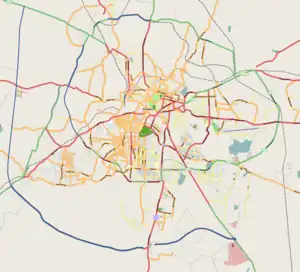| Kadu Malleshwara Temple | |
|---|---|
| Religion | |
| Affiliation | Hinduism |
| District | Bengaluru |
| Location | |
| Location | Malleshwara locality |
| State | Karnataka |
| Country | India |
 Location in Bengaluru | |
| Geographic coordinates | 13°00′18″N 77°34′17″E / 13.004966°N 77.5714462°E |
The Kadu Malleshwara Temple Kannada: ಕಾಡು ಮಲ್ಲೇಶ್ವರ is a 17th-century A.D. Hindu temple dedicated to the Shiva located in the Malleshwara locality of Bengaluru, Karnataka, India. The word 'Kadu' means forest, here referring to the thick greenery all around the temple.[1]
About
The temple was built in the 17th century A.D. by Venkoji, the brother of the Maratha King Shivaji in Dravidian style of architecture.[2] Shiva is worshipped as Mallikarjun. One part of the temple, Nandishwara Teertha Temple (Basava Theertha), is in front of the temple. It is said to be the main source or birthplace of the Vrishabhavathi River. [3][4]
Architecture
Kadu Malleshwara Temple is developed in the Dravidian engineering style amid the reign of King Venkojirao Bhonsle of Thanjavur.
Festivals
The main annual festival is Shivaratri. Thousands of devotees from Bengaluru and around visit this temple on the holy day of Shivratri festival.[3]
Connectivity
The temple is located in Malleswaram locality of Bengaluru. Bengaluru is well connected by air, road and railways. It can be reached via air at Bangalore International Airport which is located at a distance of 40 km from the city. Bengaluru receives various trains from all over the India and is well connected by roadways.
References
- ↑ "Sri Kaadu Mallikarjunaswamy Temple - Darshan - Pooja details - Opening and closing Timing". Temple Timing. Retrieved 21 November 2021.
- ↑ Dasharathi, Poornima. "A whiff of Malleswaram". Citizen Matters. Retrieved 20 October 2012.
- 1 2 "Kadu Malleshwara Temple / Sri Kaadu Mallikarjunaswamy Temple – Hindu Temple Timings, History, Location, Deity, shlokas". Retrieved 21 November 2021.
- ↑ "Sri Kaala Bhairavar Sannadhi". ePuja. Retrieved 21 November 2021.
